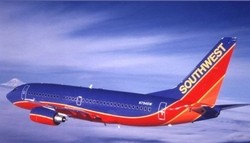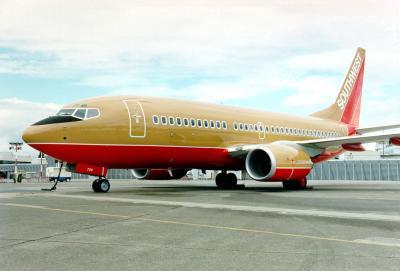'World's Largest Profitable Airline' Does it Again
 It was expected, and some of the
news is even better than expected -- for the first half of 2003
(versus the same period in 2002), RPMs were up 4.7%, overall
revenue was up 5%, with 2.9% of that in the past three months.
It was expected, and some of the
news is even better than expected -- for the first half of 2003
(versus the same period in 2002), RPMs were up 4.7%, overall
revenue was up 5%, with 2.9% of that in the past three months.
On the other hand, some expenses -- notably salaries, wages, and
benefits -- had grown a lot (14.5%). The fleet, too, is 13 aircraft
bigger than it was a year earlier.
Partially slowing the payroll upsurge was a small drop in
headcount; since Southwest simply doesn't lay people off, that drop
can be attributed to retirements and other structural unemployment
factors. Fuel and oil (up 12%) and other maintenance costs (up
6.1%) cost $55 million more than the same period last year, and it
looks at first glance that a reduction in agency commissions (down
13.8%) would go a long way to counter that. The commissions,
though, are a much-smaller piece of the expense pie, so that 13.8%
drop represents less than $5 million in savings.
Put it all together, though, and Southwest is still the big
airline to envy.
Were things better, or worse? That depends, as accountants say,
"on how you want it to come out." Most would say, "better."
 Operating income for second
quarter 2003 was $140 million, a decrease of 25.9 percent, compared
to $189 million for second quarter 2002. Excluding special items in
both years, operating income increased 13.8 percent to $181 million
for second quarter 2003, compared to $159 million for the same
period in 2002.
Operating income for second
quarter 2003 was $140 million, a decrease of 25.9 percent, compared
to $189 million for second quarter 2002. Excluding special items in
both years, operating income increased 13.8 percent to $181 million
for second quarter 2003, compared to $159 million for the same
period in 2002.
"Other income" was $257 million for second quarter 2003 versus
"other expenses" of $20 million for second quarter 2002. The $277
million swing in "other income" resulted primarily from the
government grant in second quarter 2003 and a $5 million decline in
net interest expense. Interest expense declined 14.8 percent to $23
million primarily due to lower interest rates. Interest income for
second quarter 2003 declined 22.2 percent, also due to lower
interest rates. Capitalized interest increased 60 percent to $8
million in second quarter 2003 as a result of higher Boeing
aircraft progress payments.
James F. Parker, Vice Chairman and Chief Executive Officer,
stated: "Considering the challenges we faced in second quarter with
the Iraq war and the difficult airline industry pricing
environment, we are proud of our better than expected earnings
performance. Excluding the $271 million government grant, our
second quarter 2003 net income of $103 million slightly exceeded
last year's second quarter earnings of $102 million, even though
second quarter 2002 included $36 million (pretax) related to a
reduction in air traffic liability.
"Although bookings softened early in the quarter as a result of
the war in Iraq, traffic and revenues finally began to improve in
mid-June. Thus far, traffic and load factors for this month and
bookings for the remainder of July and August are strong due to
high demand for vacation travel. Thus far in third quarter 2003,
unit revenues are exceeding year ago levels. The outlook for the
economy remains uncertain, however, and we remain concerned about
travel demand post-Labor Day."

Still growing, albeit slowly
He continued, "Although the last 22-month period has been the
most difficult ever for the airline industry, our superb Employees
remain focused more than ever on their mission to spread the
Freedom to Fly to Americans. As a consequence of their dedication
and improved revenue trends, we recently exercised our remaining
2004 options for the delivery of nine 737-700s next year. In
addition, we exercised six 2005 options for accelerated delivery in
2004 and accelerated the firm delivery of two 2005 aircraft to
2004. These changes to our Boeing 737-700 delivery schedule bring
our current 2004 firm orders to 42 aircraft, which, after
subtracting planned 737-200 retirements, results in a planned
annual capacity increase in the 6 to 7 percent range in 2004."
 Aero-News: Quote of the Day (11.26.25)
Aero-News: Quote of the Day (11.26.25) ANN's Daily Aero-Term (11.26.25): Takeoff Hold Lights (THL)
ANN's Daily Aero-Term (11.26.25): Takeoff Hold Lights (THL) ANN's Daily Aero-Linx (11.26.25)
ANN's Daily Aero-Linx (11.26.25) Airborne Affordable Flyers 11.20.25: Sonex $$$, SnF 26 MOSAIC DAY, P. Ponk STCs
Airborne Affordable Flyers 11.20.25: Sonex $$$, SnF 26 MOSAIC DAY, P. Ponk STCs ANN's Daily Aero-Linx (11.27.25)
ANN's Daily Aero-Linx (11.27.25)





